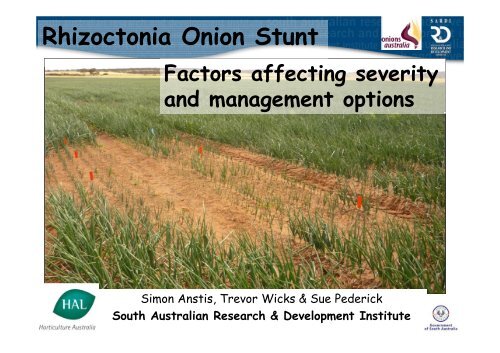Rhizoctonia Onion Stunt
Rhizoctonia Onion Stunt
Rhizoctonia Onion Stunt
Create successful ePaper yourself
Turn your PDF publications into a flip-book with our unique Google optimized e-Paper software.
<strong>Rhizoctonia</strong> <strong>Onion</strong> <strong>Stunt</strong><br />
Factors affecting severity<br />
and management options<br />
Simon Anstis, Trevor Wicks & Sue Pederick<br />
South Australian Research & Development Institute
<strong>Onion</strong> <strong>Stunt</strong><br />
• Widespread in Mallee, SA &<br />
found Columbia basin, USA<br />
• Causes undersized bulbs and<br />
economic loss<br />
• <strong>Onion</strong>s rotated with cereals<br />
increase <strong>Rhizoctonia</strong><br />
• Root damage similar<br />
to cereals<br />
- spear tips<br />
- sunken cortex
<strong>Onion</strong> <strong>Stunt</strong>- aerial view
<strong>Onion</strong> nurse crops<br />
• Associated with cereal nurse crops<br />
that protect onion seedlings from<br />
sandblast<br />
• Cereal nurse-crops used because:<br />
- rapid germination in cool soils<br />
- easily killed with herbicide<br />
- availability and cost<br />
• Barley/wheat/triticale<br />
• Alternative: above and non-host R.<br />
solani????<br />
• Timing of sowing influences stunt<br />
severity
Timing of sowing:<br />
• Some growers are moving away<br />
from sowing into established<br />
cover crops<br />
• Claim better establishment<br />
• Risk of wind damage<br />
• June/July minimal, varies with<br />
location<br />
• Late plantings prone to windblowing<br />
• <strong>Stunt</strong> risk less, late plantings
<strong>Onion</strong> stunt severity<br />
• Temperature<br />
• Moisture<br />
• Soil type<br />
Method<br />
• <strong>Onion</strong> seedling bioassay<br />
• Mallee onion soils
Effect of Temperature on <strong>Onion</strong> <strong>Stunt</strong><br />
22 C<br />
15 C<br />
Con<br />
AG 8 Con<br />
AG 8
Soil moisture and stunt severity<br />
Increasing soil moisture increases plant growth in the presence of<br />
300<br />
<strong>Rhizoctonia</strong> solani AG8<br />
250<br />
Dry Wt/pot (mg)<br />
200<br />
150<br />
100<br />
50<br />
Lsd (0.05) 39.4<br />
%WHC<br />
25<br />
50<br />
75<br />
0<br />
0 1 3<br />
<strong>Rhizoctonia</strong> propagules/pot<br />
<strong>Onion</strong> seedling growth in 5 soil types at different<br />
moisture
<strong>Onion</strong> <strong>Stunt</strong> across different soils<br />
• Over<br />
different soils<br />
proportion of<br />
coarse sand<br />
generally<br />
related to<br />
stunt severity<br />
500<br />
400<br />
300<br />
• Other<br />
parameters<br />
variable pH,<br />
mineral<br />
nutrients<br />
200<br />
100<br />
0<br />
Dry Wt (mg/pot)<br />
Coarse sand fraction<br />
69.0%<br />
86.5%<br />
49.6%<br />
72.4%<br />
Caloote Kea Keb Tailem Bend<br />
No pathogen<br />
R. solani
Soil Fumigants<br />
• Both Metham &<br />
TeloneC35 reduce<br />
soil inoculum
<strong>Onion</strong> metham fumigation response<br />
Fumigated strip through non-fumigated plot
<strong>Onion</strong> crop 2 seasons after fumigation<br />
Non-stunted areas:<br />
45 ± 21 pg AG 8 DNA/g soil<br />
• Aerial photograph<br />
onions 2 years<br />
after metham<br />
• Patches of onion<br />
stunt<br />
Patches:<br />
448 ± 58 pg AG 8 DNA/g soil
<strong>Onion</strong> <strong>Stunt</strong>: Case Study<br />
• Site preparation:<br />
• Deep ripping<br />
• Clay spreading<br />
• Deep cultivation<br />
• Levelling<br />
• Compost, lime<br />
Time of<br />
sampling<br />
R. solani<br />
pg DNA/g<br />
Before 88 ± 18<br />
After - with<br />
prep.<br />
9.9 ± 1.4<br />
After - no prep. 135 ± 22<br />
• Pathogen reduction with pivot preparation
Pivot preparation<br />
• Negligible stunting<br />
observed in final<br />
crop<br />
• Some drainage<br />
problems<br />
• Not available to all<br />
growers<br />
• Deep profile enabled<br />
this type of soil<br />
preparation<br />
• Significant cost but<br />
disease control<br />
made up for<br />
expenditure
Beneficial microbes<br />
Bacillus, Streptomyces, Trichoderma, Aspergillus<br />
based formulations evaluated in field and pot<br />
experiments<br />
• Variable response<br />
– growth of diseased plants never completely restored<br />
<strong>Onion</strong> seedlings transplants<br />
• Seedling roots soaked in fungicide solutions or Trichoderma spore<br />
suspensions<br />
• Transplanted into stunted patches<br />
• 4 weeks assessed for height, 16 weeks bulb width and weight
Seedling transplants<br />
Biological treatments more effective than chemical treatments<br />
Plant weight (g) / bulb width (cm)<br />
25<br />
20<br />
15<br />
10<br />
5<br />
0<br />
Weight<br />
Width<br />
Control Amistar Rizolex Plantmate T. harzianum<br />
Trichoderma based<br />
treatments
Fungicide evaluation<br />
• Laboratory and glasshouse studies<br />
• Field evaluation<br />
Experimental seeder and chemical injection machinery
Fungicide response<br />
• Response to soil<br />
fungicide application<br />
• 10 weeks after sowing<br />
until plant maturity<br />
• Up to 50% increase bulb<br />
wt per m seed row<br />
Treated<br />
rows
Management options<br />
<strong>Onion</strong> stunt can be managed by:<br />
• Soil working and pivot preparation<br />
• Timing of nurse crop sowing with regards<br />
to early or late planting<br />
• Fumigation<br />
• Fungicide application







![[Compatibility Mode].pdf](https://img.yumpu.com/27318716/1/190x135/compatibility-modepdf.jpg?quality=85)








